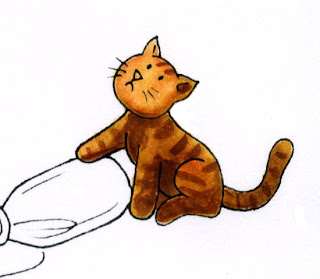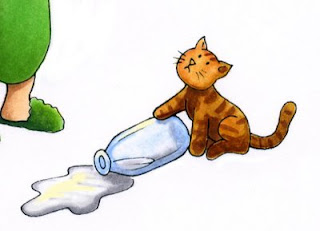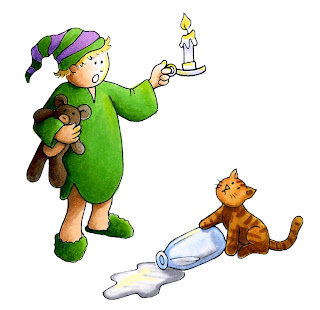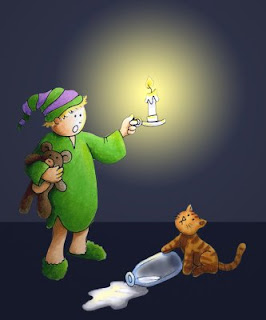This is a continuation of my
last post on shadows. Although this seems like a very simple picture, I'm labeling this advanced because of how much I'll be going in-depth about the image.
 Light from a candle
Light from a candleI drew a really cute scene and I want to step you through the process I use for coloring it. At first glance the picture is very simple. However, we have a lot of complex things going on once we try to color it.
 Light from a single source, or candle
Light from a single source, or candleThe main light source in this artwork is a candle, which is very different than the sun. From my earlier post we know the following:
• Our shadows will all move in a circle out from that point of light
• Light farther away from the candle is softer and muted.
• Shadows close to the candle are strong.
Another couple rules I want to include in our list:• Reflective/shiny surfaces pick up light from far away in the dark, even if they are in the darker areas of your image.
• In the dark, furry things don't show up as well because light has a harder time bouncing off their surface.
• Colors quickly lose intensity in the dark, so shadows will turn more gray than they would in strong sunlight.
• Things close to the light make bigger shadows than objects farther away (I'll talk about this later, not in this illustration)
Some new points to consider about candlelight:• Candles throw a warm (yellow) glow over everything that they light up.
• Light from a candle flickers and wavers, so your shadows can be softer.
• The candle wax glows from the candlelight.
• Intensity of the candle light is an artistic choice, however, in real life, candles don't give much light.
This is by no means a complete list, but these are the most important things to keep in mind.
Wow. That's a lot of things to think about. Now you see why I consider this a complex image to color. Let's break this artwork down into smaller parts and tackle it over the course of a few days.
 Shadow Study
Shadow StudyThe first place to start is with a shadow study. We have to look at the whole picture to get an idea of how it will work as a completed composition.

Instead of drawing lines where my light is coming from I am using concentric circles to show intensity. Things that are in the first circle are going to be brighter than the outer circles. How close you make your circles is an artistic choice. My circles are'nt perfect, but it gives you an idea.
I chose to make my circles pretty large and make the candle light brighter than real life so that we can see the cat on the floor better.
Notice that the teddy bear is in the arm opposite the candle and so it will mostly be in shadow. I am not going to talk about the spilled milk today, since that is a reflective surface I am going to cover it later.

 Coloring the Boy
Coloring the BoyHere is the boy colored by himself. On his night shirt I used YG06 for the lightest areas, shadowed with YG17 (a little more gray) and I blended in G28 for the deepest green areas, with a touch of BG96. His cap is V12 and V17 along with the greens.
On his skin I used E01, and I shadowed it with E33. E33 is not what I would usually use for skin shadows, but remember, in the dark the skin loses it's color intensity, so it gets dull faster. On the deepest shadows I used a touch of E44. On his face, which is closest to the candle I left it white and added a yellow highlight.
The teddy bear is E33, E44, E29 and W7. The W7 I added to make the darkest areas grayer, as they would naturally be in the dark. His hair is Y02, YR24, and E33. The candle is Y02, C1, and BV23.
 Highlights
HighlightsI left most highlight areas close to the candle un-colored so that I could add a nice, strong yellow (y02). You can see from this diagram where I added highlights. Things farther away from the candle, like the bottom of his night-shirt, I just added the yellow over the base color. If you swipe a pale color over a darker color enough times it will push the darker color out of the way. I did add some faint yellow hints to his slippers, but that's optional.
Don't forget to color the candle and the highlights on the candle holder yellow as well, since this is a source of the glow. I may add yellow to the background behind the candle after I'm all done, but I'm not worrying about that at this point (I'm thinking of airbrushing the background).
 Night Shirt
Night ShirtAs you are coloring, keep referring back to your shadow study. Notice that the boy's shirt is long, and it passes through a couple of the light circles. This means that the shirt wil gradually get darker as it gets farther away from the candle, even though the front side is well-lit from the candle.
If you look at the shadows on his legs you will also see that they fall in line from the candle, so they are darkest under his night shirt and lightest on the front side, though they aren't as pale as the skin on his face where the candle light is strongest. I also did not give his legs any yellow highlights.
What really makes this picture work so far is the contrast. Although the background is still white, you can tell at this point that the candle is bright and the boy will likely be standing in a dark room. His side far away from the candle is dark and deeply shadowed, but everything close to the candle is bright and vibrant.
I'll try to finish this picture over the next few days. I hope this has given you some things to think about.
Click here to go to part 2.
 Wow! The wholesale event for summer CHA is now over. What a blast we had in the Copic booth. It was great to see all the excitement over the new 12 colors and to have a chance to play with them as well. I'm already excited for the next CHA.
Wow! The wholesale event for summer CHA is now over. What a blast we had in the Copic booth. It was great to see all the excitement over the new 12 colors and to have a chance to play with them as well. I'm already excited for the next CHA. Another Copic Spotting-
Another Copic Spotting-





































